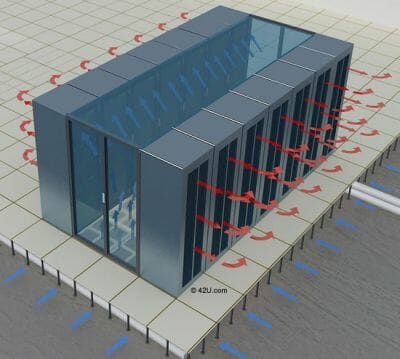Containment: When Is It Worth It?9 min read

To contain or not to contain? That is the question that more and more data centers are considering. Awareness in AFM continues to grow as containment has become a widely discussed airflow management solution and continues to gain popularity. Rudimentary containment solutions first began around 2004, and according to a SearchDataCenter survey from 2009, almost 50% of respondents had implemented some type of containment. By now, containment systems are being designed with efficiency in mind and considered, at one point or another, by the majority of the data center industry.
What is Containment?
Containment can refer to a variety of options. Hard containment takes the form of doors and panels installed from the ceiling or floor around an aisle, and soft containment usually means the “meat-locker” style curtains that segment air and prevent mixing. Partial containment is the use of either option; regardless of hard or soft, it’s installed where the worst offenders for the mixing of air might occur, usually at the end of aisles where operators walk in and out.
Full containment is certainly a tempting solution, because it’s a thorough approach to ensuring cool supply air and hot exhaust air don’t mix. While it’s a beneficial solution to a number of AFM issues, containment should only be installed after you’ve covered all AFM fundamentals and still continue to experience problems (i.e. hot spots) . If you’ve covered the 4R’s (see below) and still see issues, then it might be time to consider containment.
Risks
However, installing full containment does have a few drawbacks. It is a very expensive solution, as it requires skilled labor to install. Additionally, it also raises numerous fire suppression issues that need to be addressed depending on a location’s fire codes. There are also other potential risk factors, including: risk to down-time from significant installation activities; potential interference with overhead data and power cable management; and additional costs/labor associated with making changes to configuration of room (orientation of cabinets). Before rushing into a full containment solution, consider whether or not you’ve properly addressed the other areas.
Pre-containment checklist: Address the 4 ‘R’s
Upsite Technologies defines the 4 ‘R’s of a facility to identify areas for improved AFM, including: the raised floor, the rack, the row, and the room as a whole. While all four ‘R’s are important to address before determining if containment is necessary, the first two ‘R’s will have the most dramatic effect on reducing IT equipment intake temperatures. For the first ‘R’, sealing and managing openings in the raised floor will increase the volume of conditioned air supplied by the perforated tiles. For the second ‘R’, sealing the rack, will reduce circulation of exhaust air.
Following the 4 ‘R’s helps you to avoid the “leap frog” effect, which is the act of skipping ahead of the first-stage solutions. Although containment is relatively attractive, its benefits can be maximized only if you implement AFM at the basic levels first. Containment occurs all the way at the third ‘R’ – as a Row solution – which means the first two ‘R’s must be completed first.
Filling spaces underneath and between the cabinets (raised floor and rack) may well take care of AFM issues. A site may find that after addressing these two areas, they’re able to adjust cooling unit set points and reduce operating costs even without containment. Also, containment may be necessary in some situations where high-density cabinets are involved or poor room conditions adversely affect AFM regardless (e.g. a low ceiling).
Conclusion
AFM fundamentals of the first three ‘R’s can often provide most, if not all, the benefits at a fraction of the cost. Whether or not containment is right for you, it’s worth addressing the first three ‘R’s carefully to see if you’re still experiencing AFM issues. If you measure hotspots and coldspots after addressing those areas, then it’s worth looking into containment for problematic areas.

Airflow Management Awareness Month
Free Informative webinars every Tuesday in June.







0 Comments